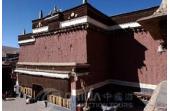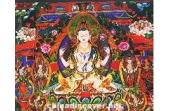Sakya, meaning "Grey Soil" in Tibetan since the soil surrounding it
is gray; its walls were painted in red, white and grey strips,
which represent Manjushri, Avalokiteshvara and Vajrapani
respectively. Sakya Monastery, reputed as the "Second Dunhuang", is
the first Sakyapa sect of Tibetan Buddhism created by its initiator
Khon Konchog Gyalpo in 1073 from which Sakyapa rose and once ruled
Tibet, occupied 14,700 square km.
It was shaped in square, and the trove including "Beiye Sutra",
"Shouxing Picture" etc. Sakya Monastery not only records the
history of the combination of religion and politics in Tibet, but
also deemed as the sign that Tibet was brought into Chinese domain
officially. Sakya Monastery has 900 years history and the Sakya
Sect ruled Tibet for more than 70 years.
So the monastery has a colossal collection of highly valuable art
pieces, including abundance handwriting sutra that is said that
copied by all the Tibetan calligraphists organized by Basiba.
Sakya's collection of treasures also contains 3,000 pieces of
sutras that have thousands of years history. The mural in Sakya
Monastery is quite different from Dunhuang that has already become
relic.
Here the mural is still passed on from generation to generation.











